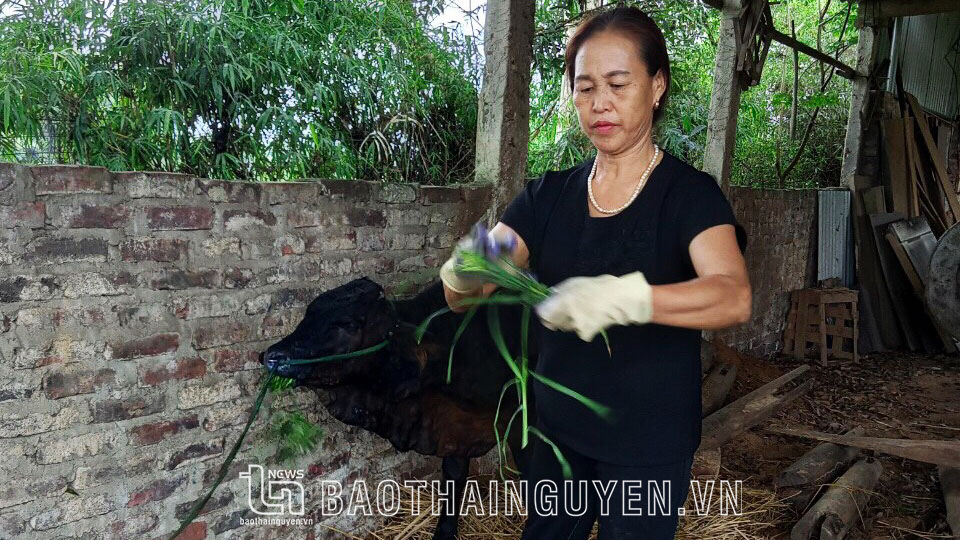Recently, lumpy skin disease (LSD) in buffaloes and cows has appeared in Khe Mo and Cay Thi communes, Song Cau town (Dong Hy) and Luong Son ward (Song Cong city). To minimize damage to livestock farmers, the provincial authorities have been implementing many control solutions to prevent the spread of the disease.
 |
| Ms. Nguyen Thi La (Ga residential group, Luong Son ward, Song Cong city) quarantined pets with lumpy skin disease. |
According to the report of the Department of Animal Husbandry, Veterinary and Aquatic Products, from April 17 to May 9, VDNC was detected in 8 cows in Khe Mo, Cay Thi communes and Song Cau town (Dong Hy). In Luong Son ward (Song Cong city), from May 30 to June 6, 2 cows were also recorded to be sick, showing signs of VDNC.
After taking samples for testing and determining that there was an outbreak of VDNC in the above localities, the Department coordinated with local authorities to implement measures to control and completely handle the outbreaks, preventing the spread of the disease in the province. Thanks to that, after more than 21 days since the outbreak of VDNC in Dong Hy district, no new cases have been reported in the area.
As for Luong Son ward, the locality has also actively implemented disease control measures. Ms. Duong Thi Luu, Chairwoman of the ward People's Committee, said: We have assigned staff to directly guide households in isolating, caring for, and treating sick and diseased livestock; cleaning and disinfecting barns and the livestock environment to destroy intermediate hosts that transmit the disease; destroying and burying 1 sick and dead cow due to VDNC according to regulations; implementing the signing of commitments with livestock households in the work of preventing and controlling VDNC; advising other households not to bring buffaloes and cows to the common grazing ground.
Luong Son Ward also conducted statistics on buffalo and cow herds that have not been vaccinated against FMD, and instructed breeders to register to buy vaccines to vaccinate their livestock... Up to this point, the locality has not discovered any more buffalo or cows infected with FMD.
Currently, hot and humid weather reduces the resistance of buffalo and cow herds and creates favorable conditions for pathogens to survive and spread widely; blood-sucking insects are reproducing and emerging in large numbers. Along with that, the care, feeding and improving the resistance of buffalo and cow herds by breeders has not received much attention. In particular, some households are still subjective, negligent, and do not vaccinate buffalo and cow herds; monitoring, detecting and reporting of epidemics at the grassroots level in some remote areas is not timely...
| As of June 18, the whole province has injected over 23,200 doses of VDNC vaccine (reaching 39% of the yearly plan). |
Faced with the high risk of outbreak and spread of ASF in the province, according to Mr. Do Dinh Trung, Deputy Head of the Department of Animal Husbandry, Veterinary and Aquatic Products: Currently, the most effective solution is still widespread vaccination. In the coming time, the unit will continue to coordinate with localities to propagate and mobilize livestock households to proactively register for ASF vaccination in the direction of socialization, striving to inject 60,000 doses of ASF vaccine (accounting for 80% of the total herd).
Along with that, localities need to strengthen inspection and supervision of disease prevention and control, comply with the 5 no principles (no hiding the disease; no buying, selling, transporting; no slaughtering for consumption; no dumping into the environment; no using unheated leftover food for livestock). Livestock infected with VDNC that die must be destroyed in accordance with disease prevention and control regulations, not allowing it to spread widely, avoiding losses for livestock farmers...
In addition, not only with the VDNC epidemic in cattle, for other epidemics in livestock herds, local authorities and people also need to proactively take preventive measures.
In 2021, the African swine fever epidemic in buffaloes and cows occurred in 641 villages and hamlets of 9/9 districts and cities in the province. The total number of buffaloes and cows infected with the disease was 2,640; the number of buffaloes and cows that died and had to be destroyed was 564 (total weight 71,479 kg). In 2022, there will be no outbreak of ASF in buffaloes and cows in the province. |
Source link


































































































Comment (0)